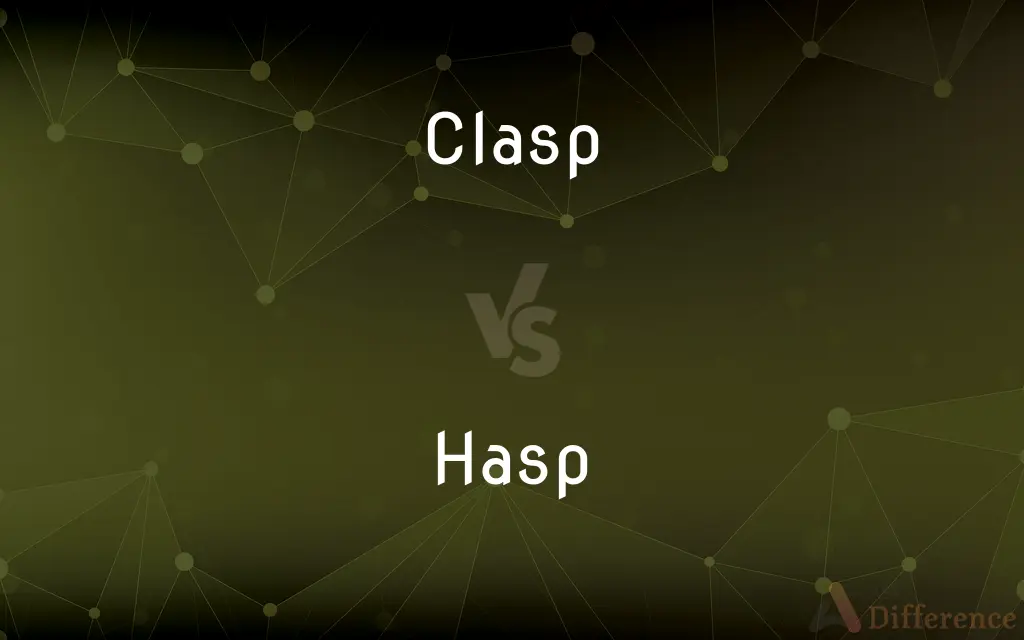Clasp vs. Hasp — What's the Difference?
By Tayyaba Rehman & Fiza Rafique — Updated on March 25, 2024
A clasp is a device for holding objects together; a hasp is a fastening device for a door or lid, often paired with a padlock.

Difference Between Clasp and Hasp
Table of Contents
ADVERTISEMENT
Key Differences
A clasp is a mechanism or device used to fasten two objects or parts together, typically found in jewelry, clothing, or bags. It is designed for ease of use, allowing for quick attachment and release. Clasps come in various forms, such as hooks, snaps, and buckles, tailored to the specific application's needs for security and aesthetic appeal. On the other hand, a hasp is a metal fastening device consisting of a hinged strap that fits over a staple (a metal loop), designed to be secured with a padlock or a pin. Hasps are commonly used for doors, chests, gates, and suitcases, providing a secure means of locking to protect against unauthorized access.
While clasps are primarily designed for functionality and ease of use with a secondary focus on aesthetics, especially in jewelry, hasps are designed with security in mind. The distinction lies in their application: clasps are for temporary and frequent attachment and detachment, as seen in necklaces and bracelets, whereas hasps are for securing items that require protection, like toolboxes and storage chests.
Another key difference is in their construction and operation. Clasps often involve a mechanism that allows them to snap or slide into place, providing a secure hold that can easily be opened by the user. Hasps, in contrast, require an external tool for locking and unlocking, such as a key or combination for the padlock, making them more suitable for long-term or high-security applications.
In terms of installation and usage, clasps are generally integrated into the design of the item they are securing, such as a piece of jewelry or a garment. Hasps, however, are installed onto the surface of an item and work in conjunction with a separate locking mechanism. This makes hasps more versatile in terms of their application but also means they can be more intrusive in appearance.
The choice between a clasp and a hasp depends on the user's needs: a clasp for everyday convenience and ease of access, and a hasp for security and protection against theft or unauthorized access.
ADVERTISEMENT
Comparison Chart
Primary Use
Fastening objects together
Securing doors, lids with a padlock
Design Focus
Ease of use, aesthetics
Security, durability
Operation
Mechanism allows easy attachment/detachment
Requires padlock or pin for securing
Application
Jewelry, clothing, bags
Doors, chests, gates, suitcases
Security
Provides a secure hold for everyday use
High security against unauthorized access
Compare with Definitions
Clasp
A device or mechanism for fastening objects together.
The necklace's clasp broke, so she couldn't wear it.
Hasp
A metal fastening for securing a door or lid, used with a padlock.
He secured the shed door with a hasp and padlock.
Clasp
Comes in various forms like hooks, snaps, and buckles.
The coat featured an intricate clasp instead of buttons.
Hasp
Consists of a hinged strap that fits over a staple.
The hasp on the ancient chest was rusted but intact.
Clasp
Often designed for both functionality and appearance.
The clasp on her bracelet doubled as a decorative feature.
Hasp
Designed primarily for security.
The storage unit was protected by a sturdy hasp.
Clasp
Used in various applications for temporary attachment.
The clasp on his backpack snapped open easily.
Hasp
Requires an external locking mechanism.
They added a hasp to the gate to use with their new padlock.
Clasp
Can be opened and closed without tools.
She appreciated the clasp's design that allowed for quick access.
Hasp
Used in applications requiring protection against unauthorized access.
The toolbox has a hasp for added security.
Clasp
Grasp (something) tightly with one's hand
He clasped her arm
Hasp
A spindle to wind yarn, thread, or silk on.
Clasp
Fasten (something) with a small brooch or similar device
One modest emerald clasped her robe
Hasp
A slotted hinged metal plate forming part of a fastening for a door or lid, fitted over a loop and secured by a pin or padlock
The hut was always locked by a large padlock securing a hasp
Clasp
A device with interlocking parts used for fastening things together
A gold bracelet with a turquoise clasp
Hasp
Lock (a door, window, or lid) by securing the hasp over the loop of the fastening
She went to the window and hasped it
Clasp
An embrace
We embraced, a tight clasp with cheeks touching
Hasp
A metal fastener with a hinged slotted part that fits over a staple and is secured by a pin, bolt, or padlock.
Clasp
A fastening, such as a hook or buckle, used to hold two or more objects or parts together.
Hasp
To close or lock with such a fastener.
Clasp
An embrace or hug.
Hasp
A clasp, especially a metal strap fastened by a padlock or a pin; also, a hook for fastening a door.
Clasp
A grip or grasp of the hand.
Hasp
An instrument for cutting the surface of grassland; a scarifier.
Clasp
A small metal bar or other device attached to the ribbon of a military decoration to indicate the action or service for which it was awarded or an additional award of the same medal.
Hasp
(transitive) To shut or fasten with a hasp.
Clasp
To fasten with or as if with a clasp.
Hasp
A clasp, especially a metal strap permanently fast at one end to a staple or pin, while the other passes over a staple, and is fastened by a padlock or a pin; also, a metallic hook for fastening a door.
Clasp
To hold in a tight embrace.
Hasp
A spindle to wind yarn, thread, or silk on.
Clasp
To grip firmly in or with the hand; grasp.
Hasp
An instrument for cutting the surface of grass land; a scarifier.
Clasp
A fastener or holder, particularly one that clasps.
I always have a hard time working the clasp on this necklace!
Hasp
To shut or fasten with a hasp.
Clasp
(in the singular) An embrace, a grasp, or handshake.
He took her hand in a firm clasp.
Hasp
A fastener for a door or lid; a hinged metal strap fits over a staple and is locked with a pin or padlock
Clasp
(transitive) To take hold of; to grasp.
They clasped hands and parted as friends.
Hasp
Secure or lock with a hasp
Clasp
To shut or fasten together with, or as if with, a clasp.
Clasp
To shut or fasten together with, or as with, a clasp; to shut or fasten (a clasp, or that which fastens with a clasp).
Clasp
To inclose and hold in the hand or with the arms; to grasp; to embrace.
Clasp
To surround and cling to; to entwine about.
Clasp
An adjustable catch, bent plate, or hook, for holding together two objects or the parts of anything, as the ends of a belt, the covers of a book, etc.
Clasp
A close embrace; a throwing of the arms around; a grasping, as with the hand.
Clasp
A fastener (as a buckle or hook) that is used to hold two things together
Clasp
The act of grasping;
He released his clasp on my arm
He has a strong grip for an old man
She kept a firm hold on the railing
Clasp
Hold firmly and tightly
Clasp
Fasten with or as if with a brooch
Clasp
Fasten with a buckle or buckles
Clasp
Grasp firmly;
The child clasped my hands
Common Curiosities
Can clasps be used for security purposes?
While clasps can secure objects, they are generally not designed for high-security applications like hasps.
Can a hasp be installed on any type of door?
Hasps can be installed on most doors, but their effectiveness and suitability depend on the door material and the desired level of security.
Do clasps require maintenance?
Yes, clasps may require cleaning and occasional adjustment or repair, especially for jewelry, to ensure proper function.
How do you choose the right hasp for a project?
Consider the level of security required, the type of padlock to be used, and the material and dimensions of the door or lid.
Where would you typically find a hasp?
On doors, chests, gates, and storage containers requiring added security.
Are there different types of clasps for jewelry?
Yes, jewelry clasps come in various designs, including lobster claws, spring rings, toggles, and magnetic clasps, each offering a balance of aesthetics and function.
What is the main purpose of a clasp?
To fasten objects together, typically for convenience and frequent use.
How does a hasp provide security?
By allowing a padlock or pin to secure the hinged strap over a staple, preventing unauthorized opening.
Can clasps and hasps be decorative?
Clasps often are decorative, especially in jewelry. Hasps are more utilitarian but can have decorative elements depending on their application.
What materials are clasps and hasps made from?
Both can be made from a variety of materials, including metal, plastic, and even fabric, depending on their intended use and required strength.
Share Your Discovery

Previous Comparison
Psycho vs. Lunatic
Next Comparison
Bandage vs. BandaidAuthor Spotlight
Written by
Tayyaba RehmanTayyaba Rehman is a distinguished writer, currently serving as a primary contributor to askdifference.com. As a researcher in semantics and etymology, Tayyaba's passion for the complexity of languages and their distinctions has found a perfect home on the platform. Tayyaba delves into the intricacies of language, distinguishing between commonly confused words and phrases, thereby providing clarity for readers worldwide.
Co-written by
Fiza RafiqueFiza Rafique is a skilled content writer at AskDifference.com, where she meticulously refines and enhances written pieces. Drawing from her vast editorial expertise, Fiza ensures clarity, accuracy, and precision in every article. Passionate about language, she continually seeks to elevate the quality of content for readers worldwide.














































